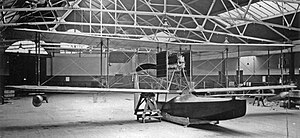Sopwith Bat Boat
| Bat Boat | |
|---|---|
 |
|
| The first Sopwith Bat Boat in the factory at Kingston-Upon-Thames c.1913. | |
| Role | Flying Boat |
| National origin | United Kingdom |
| Manufacturer | Sopwith Aviation Company |
| First flight | 1913 |
| Introduction | 1913 |
| Retired | 1915 |
| Primary users |
Royal Naval Air Service Kaiserliche Marine Greek Navy |
| Number built | 6 |
The Sopwith Bat Boats were British flying boats designed and built from 1912 to 1914. A single-engined pusher biplane, the Bat Boat was the first successful flying boat and amphibious aircraft built in the United Kingdom, with examples used by the Royal Navy and by Greece and Germany.
In summer 1912, the British pioneer aviator Thomas Sopwith, also a keen yachtman and power-boat racer, started design of a flying boat, to be called the "Bat Boat" after a flying machine in Rudyard Kipling's short story With the Night Mail, to combine his interests in aviation and the sea. The resultant design was a biplane, powered by a Gnome rotary engine in a tractor configuration. The hull, which was made of Consuta, i. (plywood sheeting sewn in place with copper wire) was built by S E Saunders, the shipbuilders based at Cowes on the Isle of Wight who were experienced in the construction of power-boats, while the wings, of about 30 ft (9.15 m) span, were built at Sopwith's flying school at Brooklands. Although the aircraft was approaching completion by August 1912, it was abandoned and was never flown.
Sopwith then produced a completely new design of flying boat, still called "Bat-boat", this time a pusher configuration two-bay biplane powered by a 90 hp (67 kW) Austro-Daimler engine. The hull, which was again built by Saunders of Consuta, accommodated two people side-by-side in an open cockpit in line with the leading edge of the wings, and had a curved, vee-profile planing bottom. The wings, of 41 ft (12.5 m) span, were unstaggered, with lateral control by wing warping. The tail, which had no fixed fin, was carried on tailbooms connected to the wings, while an additional forward elevator was fitted to the front of the hull to supplement the normal elevator fitted to the tail. The new Bat-boat was assembled at Sopwith's new factory at Kingston upon Thames early in 1913, and was displayed at the International Aero Show at Olympia, London in February that year.
...
Wikipedia
